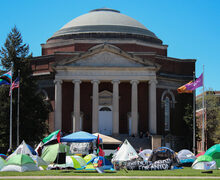Students offer up reasons for racial divide on campus
As Syracuse University attempts to make diversity an important element on campus, statistics show that the student population may have a different view.
About 71.7 percent of black and Hispanic upper-class students live on South Campus, and minority students make up 33.5 percent of the total South Campus population, according to David Kohr, the director of Housing, Meal Plan and ID Card Services.
According to Collegeboard.com, black and Hispanic students account for 10 percent of the student population at SU, with 8 percent choosing not to report their race or ethnicity.
‘There is a big difference,’ Kohr said. ‘Clearly for African-American students, South is a place of choice.’
Despite the distance from main campus, minority students are choosing the independence, sense of community and apartment-style living of South Campus in large numbers, leading to a geographic separation based on race at SU.
‘So many students of color live on South,’ Kohr said. ‘There are 120 more (black students) at South than on North,’ Kohr said.
When looking at the statistics of just upperclassmen minority students, the contrasting populations living on North and South Campus is large.
About 77.6 percent of black upperclassmen live on South Campus. Likewise, 61.2 percent of Hispanic upperclassmen choose to live on South Campus.
Freshmen comprise about 60 percent of the black and Hispanic students living on North Campus.
‘You can conclude that most of the Hispanics on North are first-year students,’ Kohr said.
Kohr believes the high numbers of black and Hispanic students on South Campus exist because of the comfort the students have living with friends from similar backgrounds. He also said the students enjoy the benefits of the area, such as cooking and personal space, that they would not have on North Campus.
Some minority students living on South Campus agree.
Cordell Enniss, a sophomore majoring in entrepreneurship and finance, believes the social scene for black and Hispanic students is more vibrant on South Campus.
‘The social aspect is a major point,’ Enniss said. ‘There’s after-parties thrown at South.’
Enniss believes that the high percentage of minority students choosing to live on South encourage other minorities to live there as well.
‘As the statistics show, the atmosphere is much more conducive (for minorities) on South,’ Enniss said. ‘Most of your friends are on South. It sucks if you’re the only person in your clique on North.’
Kohr agrees, stating that minority students choose South for the comfort of living around a small group of friends.
‘(Students) want to live with friends and feel comfortable,’ Kohr said.
For some minority students on campus, though, living with friends has little to do with ethnicity.
Theresa Moore, a sophomore undecided student in the College of Human Services and Health Professions, is currently living on North Campus with non-minority roommates.
Although Moore does not feel out of place living in a less diverse atmosphere, she does notice the trend of her friends living on South.
‘A lot of my minority friends live on South,’ Moore said. ‘It’s a lot more common.’
Amanda Chichester, a sophomore majoring in public relations, decided to live on South to be free of some of the annoying aspects of the residence halls.
‘I just like the independence,’ Chichester said. ‘(There’s) no signing in anyone, no RAs, my own bathroom and kitchen and no fire drills!’
Other South Campus residents agree that having an apartment is easier for minorities who enjoy their personal space.
‘There’s so much freedom. You have your own room, your own bathroom,’ Enniss said.
Enniss said that many black and Hispanic students are not used to living in an environment where they must share close, personal areas.
As for non-minorities, the majority choose not to live on South Campus.
‘Caucasian students live on South, but not at a larger percentage,’ Kohr said.
Some Caucasian students find living on South to be a burden.
‘I love having so much space (on South),’ said Shannon Grotzinger, a sophomore magazine and English major, ‘but I’m always on (North) Campus.’
Grotzinger did not intentionally try to live on South Campus, but because of the housing lottery, she was left to live there.
‘We were trying to get a four-person suite,’ Grotzinger said. ‘I was stuck with South.’
As for North Campus housing, Kohr said options as to where students would live were more open to freshmen years ago, creating a similar situation where students of the same backgrounds grouped together.
‘This is not different from the last five or six years,’ Kohr said.
Kohr said that prior to 2001, freshmen were able to choose their housing preference after acceptance into the university, occupying the most popular residence halls at the time, Day and Flint. Many minority students with financial aid ended up late in choosing their housing, leaving them with housing in halls such as Brewster/Boland. This resulted in a separation of students across campus.
Although housing implemented a random housing selection process, upperclassmen are still deciding to live in separate areas of campus.
Cassi Steenblok, a sophomore history major, is living on North Campus for the convenience of location.
‘It seemed more ‘collegy,” Steenblok said.
Comfortable living on North, Steenblok does not see herself moving to South Campus.
‘I don’t have any intention to live on South,’ Steenblok said. ‘I don’t think it’s for me.’
Published on October 5, 2004 at 12:00 pm




